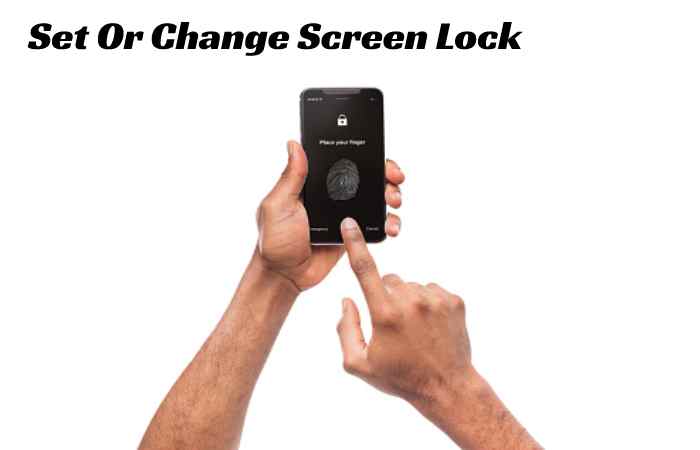Set Screen Lock On Android Device
Touch To Unlock – You can usually up a screen lock to protect your Android phone or tablet. Every time you turn on your device or wake up the screen, you’ll be prompted to unlock the machine, usually using a passcode, pattern, or password. On some models, you can open your device with your fingerprint. Some of these steps only apply to Android 10 or later. Learn how to check the version of Android installed on your device
Set Or Change Screen Lock

Important: To ensure that your automatic and manual backups are encrypted with screen lock, use a passcode, pattern, or password. Learn how to back up or refurbish data on your phone.
Open Your Phone’s Settings App.
- Tap Security.
- If you don’t see “Security,” go to your phone manufacturer’s support site for help.
- To choose the type of screen lock, tap Screen lock.
- If you’ve already set a lock type, you’ll need to enter your passcode, pattern, or password before you can choose a different one.
- Tap the screen lock choice you want to use, then follow the onscreen instructions.
Screen Lock Options
No Lock
Your phone remains unlocked. This option does not offer you any protection, but it allows you to access the home screen quickly. Swipe the screen with your finger. This option does not offer any protection but will enable you to access the home screen quickly.
Standard Locks
- Diagram: Draw a simple graph with your finger.
- Code: Enter at least four digits. More extended codes are generally more secure.
- Password: Enter at least four numbers or letters. A secure password is the safest screen lock option.
How To Unlock iPhone Without Home Button/Fingerprint?
After launching iOS 10, Apple removed the “swipe to unlock.” You must press the Home button to unlock the device and access the home screen. A new way to unlock has appeared, but it doesn’t appeal to all iPhone and iPad users.
It is possible to activate the “Touch to open” function following the iPhone 5s, so just put your finger on the Home button without having to click to unlock the iPhone with your Touch ID fingerprint.
On iOS 11/10, it is possible to activate the “Touch to open” function, so just put your finger on the Home button without having to click to unlock the iPhone using your Touch ID fingerprint. Due to frequent use of the central controller may not work after many presses. So how to open an i phone without a fingerprint? You will find valuable tips in this article.
This way, you no longer have to press the Home button to unlock your device. Make sure the lock screen is on, and then use Touch ID to unlock your iPhone or iPad.
Removing ‘Swipe To Unlock.’
With iOS 10, Apple has removed the ” slide to unlock, “slide to unlock” in French, this gesture which has allowed us to unlock the iPhone since its inception in 2007. Thus, it suddenly forces many users to get rid of an ingrained habit. And that’s not necessarily to everyone’s taste. Remember, it was 2007. Steve Jobs was performing the first public demo of the iPhone. No one at the time had seen such an excellent interface on a touchscreen terminal.
In other words, the “tap” on an icon, the swipe of the finger to scroll, the pinch to zoom in/zoom out. And also the slide to unlock, this particular gesture which, on most smartphones, allows you to go from the lock screen to the home page.
IOS 10 Buried Swipe To Unlock
Yes, but here you are, you have undoubtedly noticed it if you have switched to iOS 10: Apple has chosen to do away with the slide to unlock. To access the home screen, you must now press the Home button, the time to be identified by the Touch ID sensor or enter your code if the smartphone does not have one (like the 5C, for example).
Without the slightest form of trial, Cupertino suddenly buried a gesture that I have done daily for ten years, whether on iPhone or Android. A gesture which, by dint of performing it, had become for me as natural as breathing.
A gesture that also meant so much to Apple that the company fought hard against those who had taken it over on their mobiles, Samsung in the lead. And had even won the battle for a time, forcing Samsung to slightly modify the function on some of its flagship models before the patent was finally invalidated a few months ago.
Does Touched Make This Good Old Gesture Useless?
We can understand the logic of Apple. With the emergence of biometrics and fingerprint sensors, it is now easier than sliding your finger on the screen and then typing a code to unlock your mobile: just put your thumb or index finger on Touch ID and hop magic. The phone unlocks.
Finally, when everything is going well. On my iPhone 6, Touch ID is capricious and often asks me to repeat the procedure. My finger is slightly poorly positioned enough that it is a little bit wet… for the fingerprint sensor to lose control. Result: I often spend more time unlocking my smartphone than on the good days of the slide to unlock. Thanks, iOS 10! Note, however: that these concerns would no longer exist, according to my colleagues, using more recent smartphones with the new versions of TouchID. I ask to see.
In the meantime, it’s hard to understand why Apple didn’t even offer its users the option of keeping the old behavior. Most Android smartphones can be unlocked by their fingerprint reader… but also provide the possibility of using a code after sliding a finger on the screen. In short, their users have a choice.
Conclusion
I hope this guide successfully helps you unlock your iPhone without the Home button. You might find solutions to unlocking iPhone without a home button or Touch ID. If you have other knowledge, share it in the Comment Section. And don’t forget to start a trial on Any Unlock to remove locks on your iPhone successfully.
Also read 34 Weeks From Today – Pregnancy Calendar, Development Of Baby, Condition Of Health, And More
Numilk Net Worth – Description, New Milk Based Plant Machine, Numilk On Shark Tank, And More
Related posts
Featured Posts
Best Laptop For Streaming 2024 Gaming, Live Chart & More
The Basics Of Streaming Best Laptop For Streaming – Sticking to a schedule is an essential part of building an…
A Network Engineer – Definition, Description, Responsibility, And More
Definition A Network Engineer – Together with the technical teams, he develops a strategy to operate the company’s telecommunications infrastructure….


